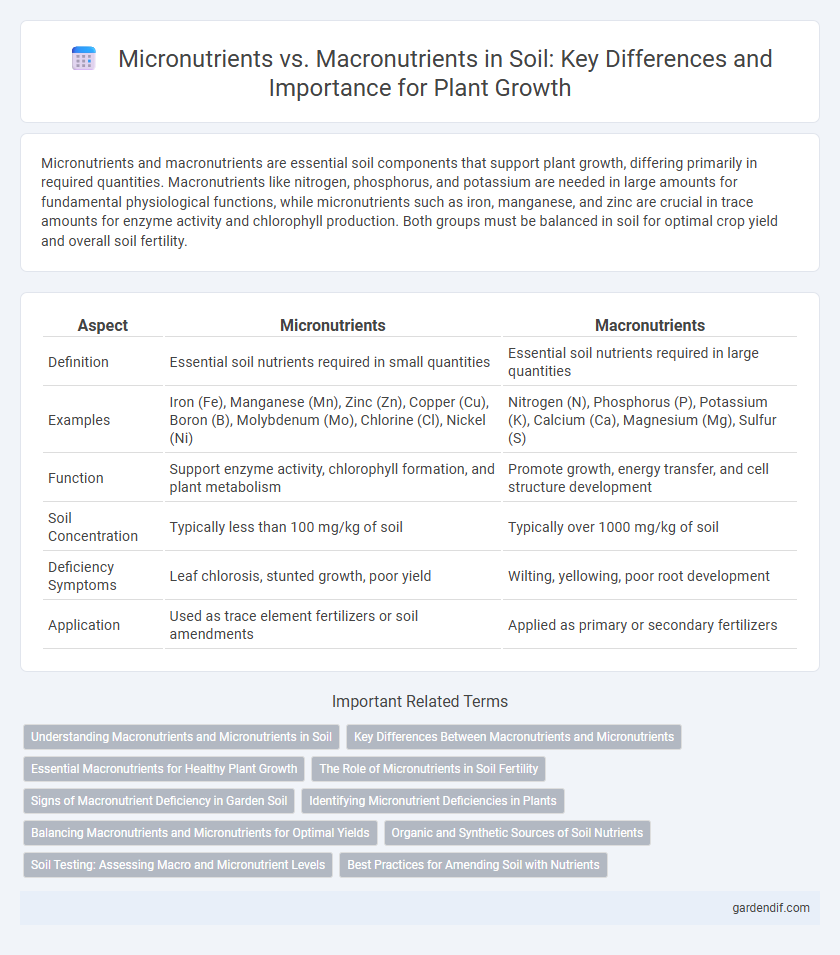
Micronutrients vs Macronutrients Illustration
Micronutrients and macronutrients are essential soil components that support plant growth, differing primarily in required quantities. Macronutrients like nitrogen, phosphorus, and potassium are needed in large amounts for fundamental physiological functions, while micronutrients such as iron, manganese, and zinc are crucial in trace amounts for enzyme activity and chlorophyll production. Both groups must be balanced in soil for optimal crop yield and overall soil fertility.
Table of Comparison
| Aspect | Micronutrients | Macronutrients |
|---|---|---|
| Definition | Essential soil nutrients required in small quantities | Essential soil nutrients required in large quantities |
| Examples | Iron (Fe), Manganese (Mn), Zinc (Zn), Copper (Cu), Boron (B), Molybdenum (Mo), Chlorine (Cl), Nickel (Ni) | Nitrogen (N), Phosphorus (P), Potassium (K), Calcium (Ca), Magnesium (Mg), Sulfur (S) |
| Function | Support enzyme activity, chlorophyll formation, and plant metabolism | Promote growth, energy transfer, and cell structure development |
| Soil Concentration | Typically less than 100 mg/kg of soil | Typically over 1000 mg/kg of soil |
| Deficiency Symptoms | Leaf chlorosis, stunted growth, poor yield | Wilting, yellowing, poor root development |
| Application | Used as trace element fertilizers or soil amendments | Applied as primary or secondary fertilizers |
Understanding Macronutrients and Micronutrients in Soil
Macronutrients in soil, including nitrogen, phosphorus, and potassium, are required in large quantities for plant growth and development, playing critical roles in functions such as photosynthesis and energy transfer. Micronutrients like iron, manganese, zinc, and copper are essential in much smaller amounts but are vital for enzyme function and chlorophyll synthesis. Proper soil management ensures balanced availability of both macronutrients and micronutrients, enhancing nutrient uptake efficiency and promoting healthy plant growth.
Key Differences Between Macronutrients and Micronutrients
Macronutrients, including nitrogen, phosphorus, and potassium, are required by plants in large quantities for growth and development, whereas micronutrients like iron, zinc, and manganese are needed in trace amounts to support enzymatic functions and physiological processes. Macronutrients primarily contribute to structural components and energy storage, while micronutrients are crucial for metabolic pathways and hormone regulation. The imbalance or deficiency of either nutrient type can lead to specific growth disorders, impacting overall soil fertility and crop yield.
Essential Macronutrients for Healthy Plant Growth
Essential macronutrients for healthy plant growth include nitrogen (N), phosphorus (P), and potassium (K), which are required in large quantities to support critical functions such as chlorophyll production, energy transfer, and root development. Secondary macronutrients like calcium (Ca), magnesium (Mg), and sulfur (S) also play vital roles in cell wall structure, enzyme activation, and protein synthesis. Deficiencies in these macronutrients can lead to stunted growth, poor yield, and increased susceptibility to diseases.
The Role of Micronutrients in Soil Fertility
Micronutrients such as iron, manganese, zinc, copper, molybdenum, boron, and chlorine play a critical role in soil fertility by enabling essential enzymatic reactions and physiological functions in plants. Despite being required in trace amounts, deficiencies in these elements can significantly limit crop yield and quality by impairing processes like photosynthesis, nitrogen fixation, and nutrient uptake. Effective soil management practices that monitor and correct micronutrient imbalances help sustain optimal plant growth and maximize agricultural productivity.
Signs of Macronutrient Deficiency in Garden Soil
Macronutrient deficiency in garden soil typically manifests through distinct signs such as yellowing leaves, stunted growth, and poor root development. Nitrogen deficiency results in pale, yellow foliage, while phosphorus scarcity leads to dark green or purplish leaves and delayed maturity. Potassium shortage causes leaf edges to brown and curl, reducing overall plant vigor and yield.
Identifying Micronutrient Deficiencies in Plants
Micronutrient deficiencies in plants often manifest as specific symptoms such as chlorosis, necrosis, or stunted growth, which vary depending on the lacking element like iron, manganese, or zinc. Soil testing combined with foliar analysis provides precise identification of micronutrient imbalances, essential for targeted fertilization strategies. Recognizing these deficiencies early ensures optimal plant health, improves photosynthesis efficiency, and prevents reduced crop yields caused by inadequate nutrient absorption.
Balancing Macronutrients and Micronutrients for Optimal Yields
Balancing macronutrients such as nitrogen, phosphorus, and potassium with essential micronutrients like iron, zinc, and manganese is critical for achieving optimal crop yields. Macronutrients support primary plant functions including growth and energy transfer, while micronutrients play vital roles in enzymatic processes and disease resistance. Proper soil testing and tailored fertilization strategies ensure nutrient availability without toxicity, promoting sustainable and productive agriculture.
Organic and Synthetic Sources of Soil Nutrients
Micronutrients such as zinc, iron, and manganese are essential in trace amounts for plant growth, while macronutrients like nitrogen, phosphorus, and potassium are required in larger quantities for soil fertility. Organic sources of soil nutrients include compost, manure, and green manure, which release nutrients slowly and improve soil structure and microbial activity. Synthetic fertilizers provide concentrated and immediate nutrients but can lead to nutrient imbalances and soil degradation if overused.
Soil Testing: Assessing Macro and Micronutrient Levels
Soil testing accurately determines both macronutrient levels such as nitrogen, phosphorus, and potassium, and micronutrients including zinc, iron, and manganese, which are essential for optimal plant growth. Understanding the balance of these nutrients through soil analysis enables precise fertilization strategies, improving crop yield and preventing nutrient imbalances. Regular soil testing supports sustainable soil management by identifying deficiencies or toxicities in macro and micronutrient concentrations.
Best Practices for Amending Soil with Nutrients
Amending soil with both micronutrients and macronutrients requires precise soil testing to identify deficiencies and optimize nutrient availability. Employing organic matter, such as compost or manure, enhances soil structure and microbial activity, facilitating better nutrient absorption for plants. Incorporating balanced fertilizer blends and maintaining proper pH levels ensures efficient uptake of essential nutrients like nitrogen, phosphorus, potassium, iron, and zinc, promoting healthy crop growth.
Micronutrients vs Macronutrients Infographic

 gardendif.com
gardendif.com